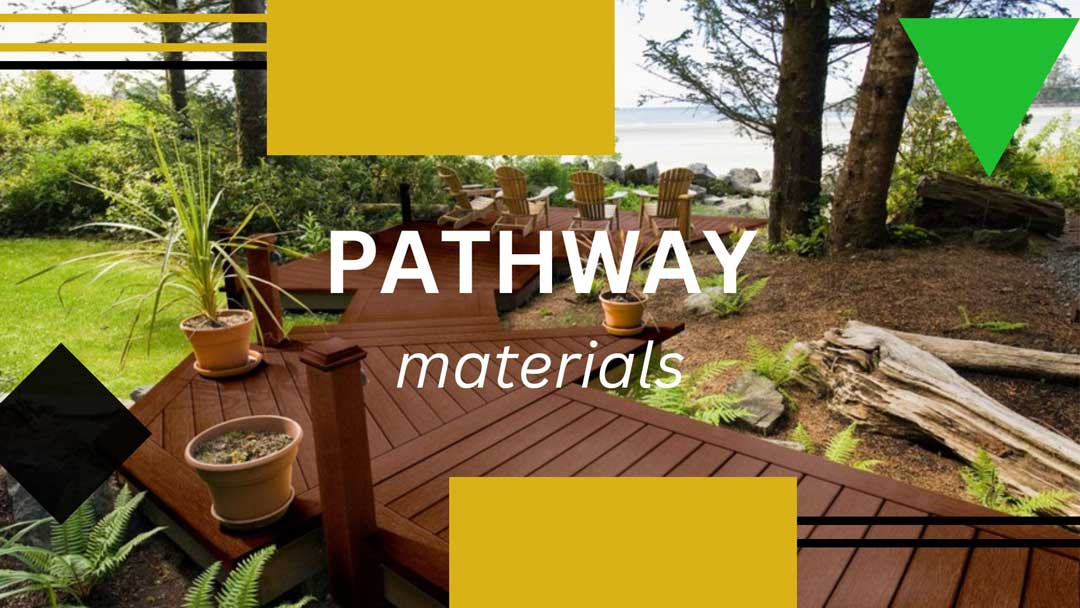Pathways are entryways to our homes, welcoming guests and enhancing our outdoor spaces. They enable seamless movement from one point to another and entice guests to explore our gardens.
There are endless possibilities with walkway designs. However, the choice of materials plays a crucial role in both functionality and visual appeal.
Walkway Paver Options
While many people associate pavers with traditional clay bricks, paving encompasses a wide range of materials. This includes;
- Precast Concrete Pavers
- Clay Bricks
- Poured Concrete
- Natural Stones such as granite
- Porcelain Pavers
- Pathway Gravel
- Wood Planks
- Asphalt
- Wood Chips
- Grass
1. Precast Concrete Pavers
First on our list; precast concrete pavers. They are made from stone aggregate, sand, cement, and other additives such as dyes. The mixture is either dry or wet cast into shaped molds and let to cure or kiln dried to harden.
Concrete pavers are durable, and weather-resistant. They offer versatility in design, shapes, sizes, and textures, and are easy to repair. These pavers are particularly well-suited for wet environments and can handle heavy foot traffic without damage.
Interlocking pavers are perfect for any surface and can be laid on sand or solid concrete slabs.
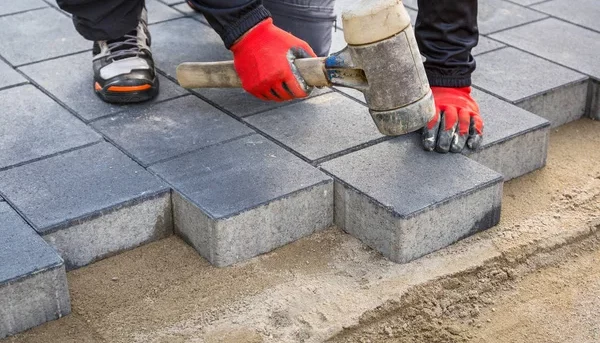
2. Clay Brick Pavers
Clay bricks are timeless, imparting a natural beauty, warmth, and elegance to your path. Brick paths invite you to explore what lies ahead.
Because bricks come in various colors and textures that can be laid in a multitude of patterns. The most common configuration is probably running bond and the strongest is herringbone.
They can be used to create everything from regal walkways to homey paths with plant- or moss-filled gaps. In addition, they mix well with other materials. For instance, brick is an excellent edging for gravel paths
However, old brick may crack or crumble in winter climates. Bricks also tend to grow mossy and slick in rainy climates and get hot underfoot in sunny areas.
Paving bricks can be purchased through brick suppliers, tile companies, and home and building supply centers. Most suppliers will deliver for a fee. Be sure you are buying paving bricks rather than facing bricks, which are intended for wall siding.
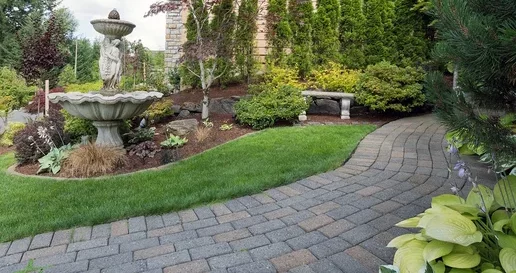
3. Poured Concrete
One of the least expensive materials is concrete.
Concrete’s versatility allows you to be quite imaginative. It can be poured into curved or symmetrical forms. It can be colored, patterned, stamped to mimic natural stone, or embedded with materials such as pebbles, shells, brick, and crushed tile. Concrete can also be textured with brooms, leaf imprints, or burlap, and different floats used to vary the smoothness.
However, it is a bit tricky for beginners and unforgiving of mistakes. Once it has hardened, chances are you will have to break your path to pieces and start over if you want to make changes.
Bags of concrete can be purchased at home and building supply centers priced per bag. Most will deliver for a fee. For large jobs, buy in bulk (Portland cement, sand, and aggregate)and rent a power cement mixer, or order ready-to-pour concrete by the cubic yard.

4. Natural Stone paths
Real stone labs look wonderful in any garden.
The random shapes and aged surfaces of natural stone create a rustic, informal look. Some have very attractive colors. Conversely, their irregular gaps leave perfect spots for planting.
However, stones with irregular surfaces will collect puddles when it rains. Small, dry-laid stone is subject to frost heave in cold winter
Types of natural stone pavers
There are various types of stones available, each with its own set of advantages and disadvantages.
By shape:
Natural stone pavers offer versatility in terms of shape, including flagstones, cobblestones, and dimensional cuts.
- Flagstones are a broad term describing irregularly or randomly shaped stones usually 3 to 5 inches thick. Arranging flagstones on a path is much like solving a puzzle but any arrangement should take into account proper foot placement.
- Cobbles are square or cuboid-shaped stone setts. Typically 10 inches long, 4 inches wide, and four deep. Great for curved paths. You may have come across them while on a trip to Europe; on streets, lanes, or courtyards.
- Cut stone refer to stones that have been precisely cut into specific shapes like rectangles and squares. Usually flat on one or both sides providing a smooth walking surface. Used in more formal settings where features tend to be more symmetrical but can be used in an informal garden as stepping stones.
- Fieldstone is any naturally occurring stone that has been collected from fields or dry-laid walls. Typically has an aged look and random shapes.

Stone options
Natural stones that can withstand the rigors of the outdoors include Granite, Limestone, Slate, Basalt/Bluestone, Travertine, Sandstone, Soapstone, Quartzite, and Cantera.
- Granite: Light-colored, coarse-grained rock. Has excellent abrasion, chemical and weathering, and slip resistance.
- Limestone: Provides excellent non-slip properties, and remains cool under intense heat. A protective coat must be applied as the stone is porous. Often confused for travertine.
- Slate: While it is commonly used outdoors, caution and proper installation techniques are necessary. Its surface sloughs off over time, and it is so slick, and so very slippery when wet
- Travertine: Leans towards beige, brown, walnut, and silvery gray tones. Travertine pavers have a porous, non-slip surface. Can scratch and stain easily.
- Basalt/Bluestone: exceptionally durable and abrasion-resistant. It comes in bold black and charcoal colors. However, it absorbs heat and retains it for a longer time.
- Quartzite: Quartzite offers vibrant shades and exceptional durability. It possesses the beauty of marble with added resistance to staining and weathering.
- Sandstone: Comes in rich brown and beige colors. Requires proper maintenance to avoid discoloration and mold formation.
- Soapstone: Available in various shades of gray with white veining but may fade over time due to UV exposure.
- Cantera: This highly durable stone comes in a wide array of colors, offering strength, versatility, and neutral earthy appeal.
You can purchase stone from masonry suppliers, stone yards, and tile companies. They can be transported in a pickup truck or delivered to your site for a fee depending on the distance.
Because stone is sold by the ton, prices vary greatly according to the thickness and type of stone. Some colors are more expensive than others. Fieldstone, which is labor-intensive to gather, is more costly than quarried stone. And you’ll pay more if you want to hand-pick your stones at a quarry.
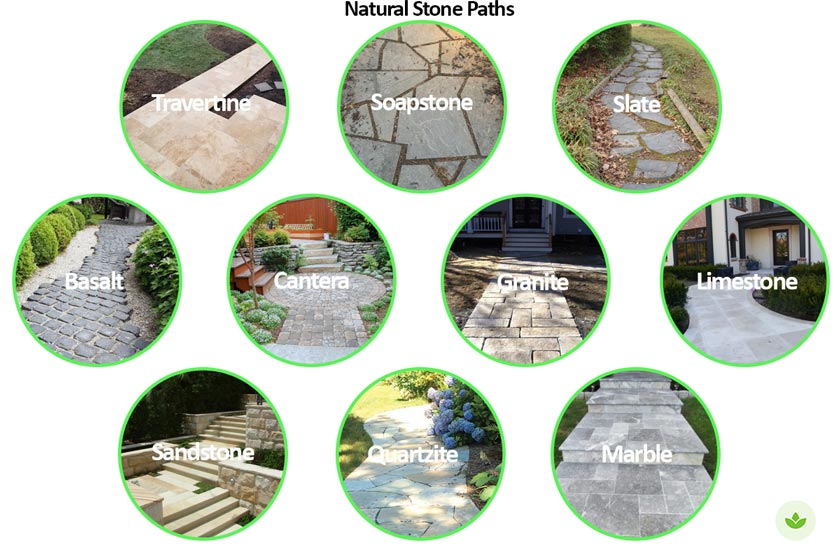
5. Porcelain
Porcelain pavers are an exceptionally strong pathway material that can withstand the harsh outdoors.
It comes in an array of colors, textures, and patterns that closely resemble cut stone. Porcelain pavers are designed to provide excellent traction and do not need to be sealed as they can be easily cleaned once stained.
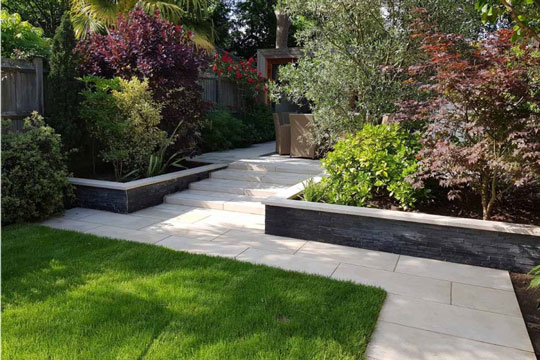
6. Pathway Gravel
Gravel and decorative pebbles are composed of loose rock fragments. It is an inexpensive option and very effective when used in conjunction with paving slabs.
They add ribbon texture, color, and sound (nice crunching underfoot) to both formal and informal areas. They are among the least expensive to build, drain quickly, hold well on moderate slopes, and retain their shape if the ground heaves.
However, gravel paths can wash on steep slopes and weeds can invade them. The pebbly materials can also be tracked inside if the path is near a door. You may also need to occasionally rake spillage back onto the path and replenish the gravel.
It is essential to contain gravel with some sort of edging to prevent it from slipping into flowerbeds or adjacent lawns. Wood, preformed plastic or metal edging, stone, concrete blocks, and bricks are some of the most popular edging materials.
Gravel or stone any larger than 4 inches (2 cm) can be difficult to walk on. For best results, select – inch stones (1 cm).
Gravel options include;
- Pea gravel or pea stone
- Crushed stones are rough and angular.
- Decomposed granite or DG
- River rock or pebbles
Gravel and ornamental rock materials can be purchased from sand and gravel suppliers. You’ll get the best pricing by buying in bulk at a quarry, or a sand and gravel yard. For smaller projects, bags of pebbles are available at home, garden, and building supply stores.
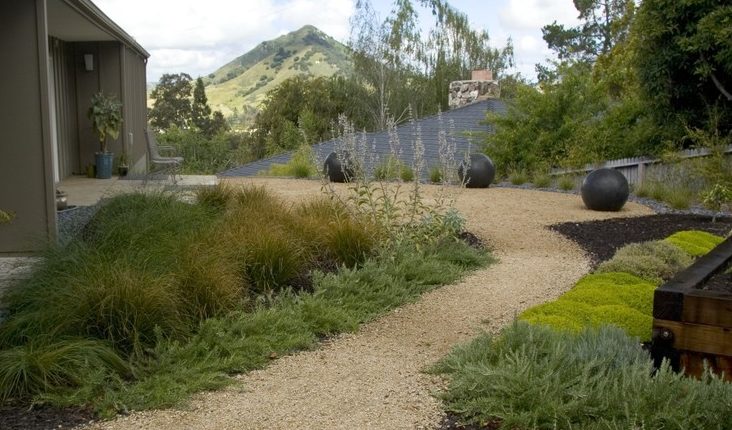
7. Wood planks
Apart from being the most common decking material, lumber/wood is often used for steps and sometimes to surface paths and patios as well.
Sliced tree trunks provide an inexpensive material for stepping stone pathways, although they become slippery in wet weather. Old railroad ties, made from tough hardwoods, are also well suited for surfacing paths. They also make very unusual steps and may be used, together with other materials. Debarked logs, which do not need to be perfectly rounded, are also good material for informal steps
Wood planks can be placed side to side on a relatively flat surface or raised using posts, riser boards, and joists to create a raised boardwalk similar to the one in the photo below. Over time, the wood naturally weathers for a rustic aesthetic that blends seamlessly with the surroundings.

8. Asphalt Pathways
Asphalt can also be utilized to create durable pathways. It is low-cost, durable, and eco-friendly as it can be recycled and reused.
It is either rolled on by specialist contractors while hot or applied cold. The cold mix variety is aimed at the home improvement market and is relatively simple to lay. It is, however, not as hard wearing as hot rolled asphalt.
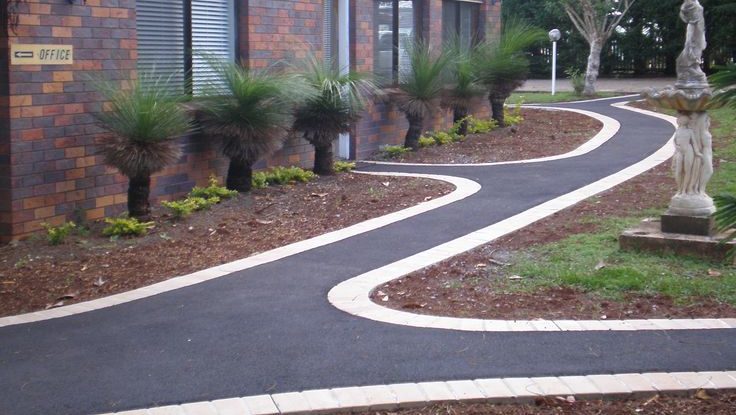
9. Wood Chip Paths
Wood chips or mulch are commonly used in smaller natural informal garden paths with minimal foot traffic and play areas. These paths are the least expensive and easiest to build. The visual effect is similar to that of gravel.
A major disadvantage is that the chips scatter easily, especially in high winds or when walked on. It can become soggy and muddy in wet weather.
You can get wood chips from public work departments, sawmills, farms, or local tree trimming services by the truckload or the bale. Some materials you can collect yourself in the woods or other areas.

10. Lawn Paths
Although grass eventually becomes worn down by constant foot traffic, it is sometimes the best choice for paths and walkways. Choose a tough grass variety and be prepared to mow, feed, and water it.
Grass should not be regarded as a low-maintenance surface. It is a reasonable temporary solution for some, and it can be used as a more permanent material in combination with hard surfaces such as stepping stones.
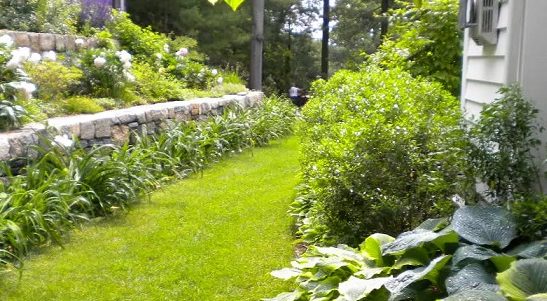
Choosing the Best Material
The material you choose will depend on several factors, including the role of the path, the garden style, and the style you want to recreate. Consider these among other elements. For instance, a purely function path leading to the front door should be surfaced with a nonslip material.
Look for the clues provided by the materials or style of your house, outbuildings, existing pathways, or steps within the garden. Consider the impact your choice will have on your choice elsewhere in the garden and how to transition between, so you do not end up with paths that feel unrelated.
Think about the investment, both in time and money, installation and maintenance. It is best to use relatively inexpensive and locally available materials. Ask local suppliers (and other path builders) about available materials.
The weather or climate will impact your choice of paving, and the base on which it should be laid. For example, concrete may crack and bricks may unsettle in deep freezes that cause the ground to heave; some cut stone and stepping-stone paths will be slippery when it’s wet and grass paths need adequate moisture and sunlight.
The terrain should also guide your choice of materials. Certain materials are better for paths that slope. Gravel, for instance, is less likely than mulch to wash downslope in heavy rain, and it won’t be as slippery as slate pavers when it’s wet.
In many instances, it is possible to combine various materials for effects as well as convenience. For example, a simple stepping stone path may join with conventional brick steps leading to a brick-paved patio. However, don’t mix too many different materials as the effect could become disoriented rather than interesting.
Finally, note whether there are nearby trees whose roots will grow and eventually cause your path to buckle (oaks and maples are notorious offenders). If so, you may want to use flexible materials rather than concrete or brick as paving materials. The tree roots can crack concrete and reduce your brick walk to rubble. Other ways to deal with trees are to prune the tree roots or re-route the path.

